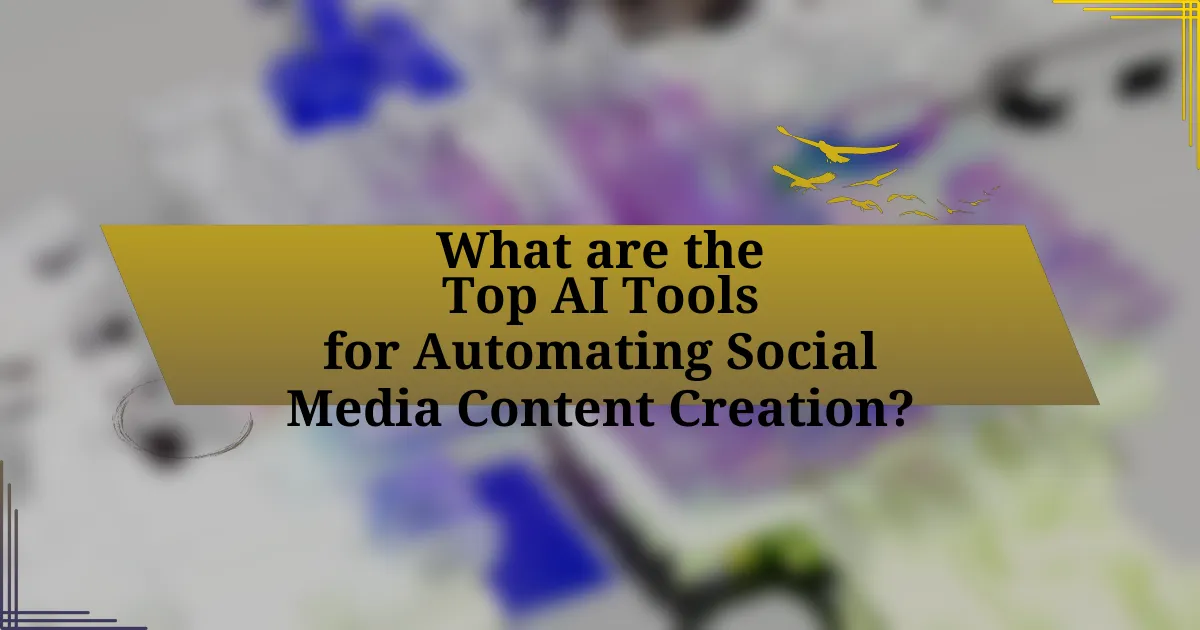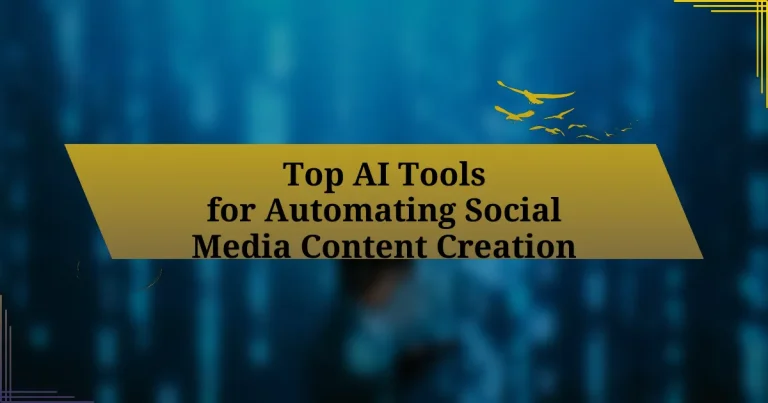The article focuses on the top AI tools for automating social media content creation, highlighting prominent platforms such as Canva, Hootsuite, Buffer, and Lately. It discusses how these tools enhance content generation through automation, optimization, and scheduling, ultimately improving efficiency and engagement. Key features of these tools include automated text creation, performance analytics, and user-friendly interfaces, which cater to various user needs and budgets. The article also addresses the importance of automation in maintaining a consistent online presence, the challenges of manual content creation, and best practices for effectively integrating AI tools into existing workflows.

What are the Top AI Tools for Automating Social Media Content Creation?
The top AI tools for automating social media content creation include Canva, Hootsuite, Buffer, and Lately. Canva offers design templates and AI-driven suggestions for creating visually appealing posts. Hootsuite provides scheduling and analytics features, allowing users to manage multiple social media accounts efficiently. Buffer focuses on content scheduling and performance tracking, enabling users to optimize their posting strategies. Lately uses AI to analyze existing content and generate social media posts that resonate with target audiences. These tools are widely recognized for enhancing productivity and engagement in social media marketing.
How do these AI tools enhance social media content creation?
AI tools enhance social media content creation by automating the generation, curation, and optimization of content. These tools utilize natural language processing and machine learning algorithms to analyze audience preferences, enabling the creation of tailored posts that resonate with specific demographics. For instance, platforms like Canva and Lately leverage AI to suggest design elements and generate text based on trending topics, which increases engagement rates. Additionally, AI-driven analytics tools provide insights into performance metrics, allowing creators to refine their strategies based on data-driven feedback. This combination of automation and analytics leads to more efficient content production and improved audience interaction.
What features do these tools offer for content generation?
These tools for content generation offer features such as automated text creation, content optimization, and social media scheduling. Automated text creation allows users to generate articles, posts, and captions quickly, utilizing algorithms that analyze existing content for style and tone. Content optimization features enhance the generated material by suggesting keywords, improving readability, and ensuring SEO compliance. Social media scheduling capabilities enable users to plan and publish content across multiple platforms at optimal times, increasing engagement and reach. These functionalities streamline the content creation process, making it efficient and effective for social media marketing.
How do AI tools improve efficiency in content scheduling?
AI tools improve efficiency in content scheduling by automating the planning and posting processes, which reduces manual effort and time. These tools utilize algorithms to analyze audience engagement patterns, allowing for optimal posting times that enhance visibility and interaction. For instance, platforms like Buffer and Hootsuite leverage AI to suggest the best times to post based on historical data, leading to increased engagement rates. Additionally, AI can streamline content curation by recommending relevant topics and automating repetitive tasks, further enhancing productivity for social media managers.
Why is automation important in social media content creation?
Automation is important in social media content creation because it enhances efficiency and consistency in posting. By automating tasks such as scheduling, content curation, and analytics tracking, brands can maintain a steady online presence without the need for constant manual input. Research indicates that businesses using automation tools can increase their social media engagement by up to 50%, as they can focus on strategy and creativity rather than repetitive tasks. This leads to improved audience interaction and better resource allocation, ultimately driving higher returns on investment in social media marketing.
What challenges does manual content creation present?
Manual content creation presents several challenges, including time consumption, inconsistency in quality, and scalability issues. The process often requires significant time investment, as creators must research, write, edit, and publish content, which can lead to delays in content delivery. Additionally, maintaining a consistent tone and style across various pieces can be difficult, resulting in varied quality that may confuse the audience. Furthermore, manual creation limits the ability to scale content production; as demand increases, it becomes challenging to produce the same volume of high-quality content without additional resources. These challenges highlight the need for automation tools that can streamline content creation processes.
How does automation impact engagement and reach?
Automation significantly enhances engagement and reach by streamlining content distribution and optimizing posting times. Automated tools analyze audience behavior, allowing for targeted content delivery that aligns with user preferences, which can lead to higher interaction rates. For instance, studies show that brands using automation for social media scheduling experience up to 30% more engagement compared to those that do not. Additionally, automation enables consistent posting, which keeps audiences engaged and increases visibility across platforms, ultimately expanding reach.

Which AI Tools are Leading the Market?
The leading AI tools in the market for automating social media content creation include Hootsuite, Buffer, and Sprout Social. Hootsuite offers comprehensive scheduling and analytics features, allowing users to manage multiple social media accounts efficiently. Buffer is known for its user-friendly interface and effective post-scheduling capabilities, which help optimize engagement. Sprout Social provides robust analytics and reporting tools, enabling businesses to track performance and refine their strategies. These tools are widely recognized for their effectiveness and have garnered significant user bases, validating their market leadership.
What are the top-rated AI tools for social media content creation?
The top-rated AI tools for social media content creation include Canva, Lately, and Jasper. Canva offers a user-friendly interface with AI-driven design suggestions, making it easy to create visually appealing posts. Lately utilizes AI to analyze content performance and generate social media posts tailored to audience engagement, enhancing marketing strategies. Jasper, known for its advanced natural language processing capabilities, assists users in generating high-quality written content for various platforms, ensuring consistency and relevance. These tools are widely recognized for their effectiveness in streamlining the content creation process and improving overall social media engagement.
What unique features set these tools apart from others?
The unique features that set top AI tools for automating social media content creation apart from others include advanced natural language processing capabilities, customizable content generation, and integration with multiple social media platforms. These tools utilize sophisticated algorithms to analyze audience engagement and optimize content for specific demographics, enhancing user interaction. For instance, tools like Jasper and Copy.ai offer templates tailored for various social media formats, allowing users to create platform-specific content efficiently. Additionally, features such as real-time analytics and performance tracking enable users to refine their strategies based on data-driven insights, which is crucial for maximizing reach and engagement.
How do user reviews reflect the effectiveness of these tools?
User reviews reflect the effectiveness of AI tools for automating social media content creation by providing firsthand accounts of user experiences and outcomes. These reviews often highlight specific features, ease of use, and the impact on productivity, allowing potential users to gauge the tools’ performance. For instance, a study by BrightLocal in 2022 found that 91% of consumers read online reviews, indicating their significant influence on decision-making. Positive reviews typically emphasize successful content generation and time savings, while negative reviews may point out limitations or challenges, offering a balanced view of the tools’ capabilities. This collective feedback serves as a valuable resource for assessing the tools’ effectiveness in real-world applications.
How do pricing models vary among these AI tools?
Pricing models among AI tools for automating social media content creation vary significantly, typically encompassing subscription-based, pay-per-use, and tiered pricing structures. Subscription-based models often charge a monthly or annual fee for access to a suite of features, while pay-per-use models charge based on the volume of content generated or specific features utilized. Tiered pricing structures provide different levels of service at varying price points, allowing users to select a plan that aligns with their needs and budget. For instance, tools like Hootsuite and Buffer offer subscription plans with varying features, while tools like Canva may have a freemium model with additional costs for premium features. This diversity in pricing models allows users to choose options that best fit their usage patterns and financial constraints.
What are the subscription options available for users?
The subscription options available for users typically include monthly, quarterly, and annual plans. Monthly plans allow users to pay on a month-to-month basis, providing flexibility, while quarterly plans often offer a slight discount for committing to three months. Annual plans usually provide the best value, with significant savings compared to the monthly rate, incentivizing long-term commitment. These options cater to different user needs and budgets, making it easier for individuals and businesses to choose a plan that aligns with their social media content creation goals.
How does the cost correlate with the features offered?
The cost of AI tools for automating social media content creation typically correlates positively with the range and sophistication of features offered. Higher-priced tools often provide advanced functionalities such as AI-driven analytics, multi-platform integration, and customizable content generation, which enhance user experience and effectiveness. For instance, tools priced above $100 per month frequently include features like automated scheduling, performance tracking, and audience targeting, while lower-cost options may only offer basic posting capabilities. This trend is supported by market analysis, which shows that premium tools tend to attract businesses seeking comprehensive solutions, thus justifying their higher price points through enhanced productivity and ROI.

How to Choose the Right AI Tool for Your Needs?
To choose the right AI tool for your needs, first identify your specific requirements, such as the type of content you want to create, the platforms you will use, and your budget. For instance, if you need to generate engaging social media posts, look for tools that specialize in social media content creation, like Canva or Buffer, which offer templates and scheduling features. Additionally, consider the tool’s ease of use, integration capabilities with other software, and customer support. Research user reviews and case studies to validate the effectiveness of the tool in meeting similar needs.
What factors should you consider when selecting an AI tool?
When selecting an AI tool, consider its compatibility with your existing systems, the specific features it offers, and its scalability. Compatibility ensures seamless integration into your workflow, while features like natural language processing and analytics capabilities directly impact the tool’s effectiveness in automating social media content creation. Scalability is crucial for adapting to future growth and increased content demands. According to a report by McKinsey, 70% of organizations cite integration with existing technology as a key factor in successful AI implementation, highlighting the importance of these considerations.
How important is user interface and ease of use?
User interface and ease of use are critically important in the context of AI tools for automating social media content creation. A well-designed user interface enhances user engagement and productivity, allowing users to navigate the tool efficiently and effectively. Research indicates that 70% of users abandon applications due to poor usability, highlighting the necessity for intuitive design. Furthermore, tools that prioritize ease of use can significantly reduce the learning curve, enabling users to focus on content creation rather than struggling with complex functionalities. This correlation between user interface quality and user satisfaction underscores the importance of these factors in the success of AI tools in this domain.
What role does customer support play in your decision?
Customer support plays a critical role in the decision-making process for selecting AI tools for automating social media content creation. Effective customer support ensures that users can quickly resolve issues, receive guidance on tool functionalities, and maximize the benefits of the software. According to a survey by HubSpot, 93% of customers are likely to make repeat purchases with companies that offer excellent customer service, highlighting its importance in influencing purchasing decisions.
What are the common pitfalls to avoid when using AI tools?
Common pitfalls to avoid when using AI tools include over-reliance on automation, lack of human oversight, and ignoring data privacy concerns. Over-reliance on automation can lead to generic content that lacks authenticity, as AI-generated posts may not resonate with the target audience. Lack of human oversight can result in the dissemination of inaccurate or inappropriate content, as AI tools may misinterpret context or tone. Ignoring data privacy concerns can expose sensitive information, as many AI tools require access to user data to function effectively. These pitfalls highlight the importance of balancing AI capabilities with human judgment and ethical considerations in social media content creation.
How can over-reliance on automation harm your brand voice?
Over-reliance on automation can dilute your brand voice by creating content that lacks authenticity and emotional connection. When brands depend heavily on automated tools, they risk producing generic messages that do not resonate with their audience, leading to a disconnection between the brand and its consumers. Research indicates that 70% of consumers prefer personalized interactions, which automated content often fails to deliver. This lack of personalization can result in decreased engagement and loyalty, ultimately harming the brand’s reputation and effectiveness in communication.
What strategies can mitigate the risks of using AI tools?
To mitigate the risks of using AI tools, organizations should implement robust governance frameworks, conduct regular audits, and ensure transparency in AI decision-making processes. Establishing governance frameworks helps define roles, responsibilities, and ethical guidelines for AI usage, which is crucial for maintaining accountability. Regular audits can identify biases and inaccuracies in AI outputs, as evidenced by studies showing that unchecked AI can perpetuate existing biases, leading to skewed results. Transparency in AI processes fosters trust among users and stakeholders, as it allows for scrutiny and understanding of how AI systems arrive at their conclusions.
What are some best practices for maximizing the use of AI tools?
To maximize the use of AI tools, users should integrate them into their workflows effectively. This involves selecting the right AI tools that align with specific tasks, such as content generation or data analysis, and ensuring that team members are trained to utilize these tools efficiently. Research indicates that organizations that provide training on AI tools see a 30% increase in productivity (McKinsey & Company, 2021). Additionally, regularly updating and maintaining AI tools ensures they operate at peak performance, which is crucial for tasks like automating social media content creation.
How can you integrate AI tools into your existing workflow?
To integrate AI tools into your existing workflow, first identify specific tasks that can benefit from automation, such as content generation or scheduling. Next, select appropriate AI tools that align with these tasks, like content creation platforms or social media management software. For instance, tools like Hootsuite or Buffer can automate posting, while AI writing assistants can help generate engaging content. Implement these tools by training your team on their use and gradually incorporating them into daily operations, ensuring a smooth transition. Studies show that businesses using AI for social media management can increase engagement rates by up to 50%, demonstrating the effectiveness of these integrations.
What tips can enhance the quality of AI-generated content?
To enhance the quality of AI-generated content, it is essential to provide clear and specific prompts that guide the AI in generating relevant and coherent text. Clear prompts help the AI understand the context and desired tone, leading to more accurate outputs. Research indicates that well-defined input significantly improves the relevance and quality of generated content, as seen in studies on prompt engineering, which highlight the importance of specificity in achieving desired results.

